REEL RETRO CINEMA: New looks at old flicks — and their comic-book connections…

By ROB KELLY
Killdozer (which really should be titled Killdozer!) is a 1974 TV movie starring Clint Walker, Carl Betz, Neville Brand, James Wainright, James A. Watson and Robert Urich as construction workers who unwittingly uncover a meteorite that is possessed by a mysterious force from outer space. Once uncovered, the energy contained in the meteor transfers itself to the bulldozer that dug it up, turning it into a sentient killing machine.
One of the workers, Mack (Urich), dies soon after, possibly from the radiation emitted from the meteor. The bulldozer in question starts malfunctioning, but no one can figure out why, so the foreman Lloyd Kelly (Walker) orders his crew to stop using it. One of the men ignores this and starts it up, bringing it back to life. Killdozer then demolishes the camp radio, stopping anyone from calling for help. The bulldozer attacks other members of the crew, showing some rudimentary intelligence and an ability to keep moving even though it is out of fuel.

Eventually, only Kelly and Dennis Holvig (Betz) are left. Running out of options, they devise a trap for the bulldozer, “luring” it to roll over an electrified steel grating, which shorts Killdozer out and sets it on fire. The energy that possessed the machine emerges, fading away to nothing. Knowing a rescue crew will eventually arrive, Kelly and Holvig debate whether to tell everyone what really happened, even though they know it will sound completely unbelievable. Kelly decides telling the truth is the only option.

Killdozer is based on a 1944 novella by the legendary Theodore Sturgeon. In his original story, the crew is working on building an airstrip on a small Pacific island as part of the war effort, and opens with an elaborate back story set billions of years ago. The movie, produced by Herb Solow (one of the people who helped bring Star Trek to TV in 1966), didn’t have the budget for such expensive scenarios; so instead, it’s modern day on a small African island.
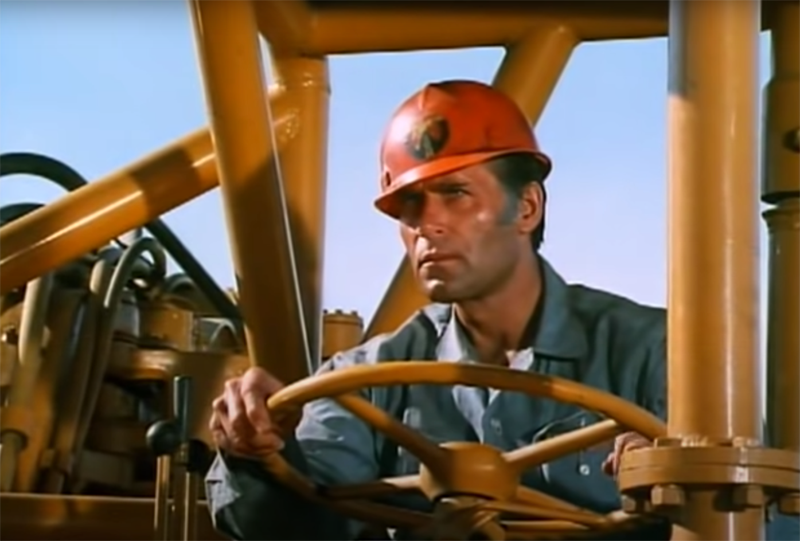
Clint Walker
There are lots of examples of “machine goes amok” in popular entertainment, and it’s all in the execution: Can the filmmakers pull of the absurd premise? Killdozer has a few things going against it, in that bulldozers inherently can’t go that fast, and they are too damn noisy to be able to sneak up on anyone. So how many kills can it pull off before the characters start looking like complete idiots? Just move out the way! Luckily, with Killdozer’s remote setting and very limited cast, it only takes one or two kills before the rest of the crew figures out the trouble they’re in. At a brisk 74 minutes, Killdozer wraps up before it wears out its welcome.
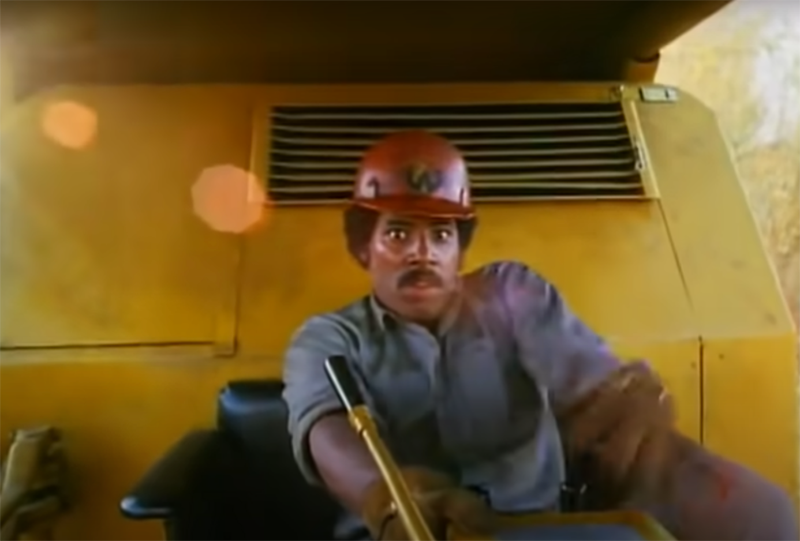
James A. Watson
Released two months after the movie, Marvel Comics adapted Killdozer in the sixth issue of Worlds Unknown, written by Gerry Conway and drawn by Dick Ayers. One look at the absolutely bonkers cover by Gil Kane and Ernie Chan shows that the House of Ideas was not going to be limited by the constraints of real-life film production.
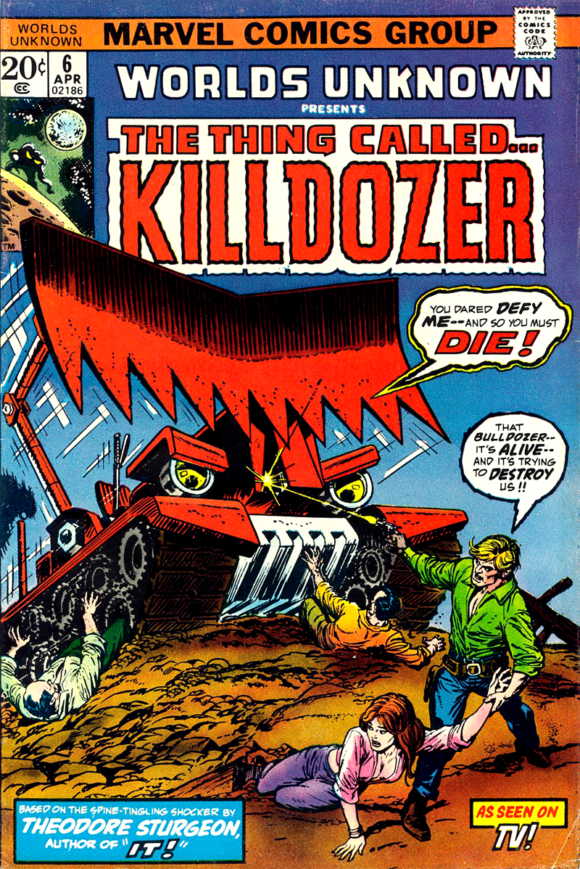
The comic book version uses elements from both the novella and the movie. For instance, like the book, it opens billions of years in the past, dramatizing a great battle between a race of beings and sentient electrons, which took over all the machines and turned against their creators, leading to total destruction. Cut to: present day, where an intrepid band of men are on a faraway island, contracted to build an Air Force landing strip. Conway does not waste time: Here, the mysterious force takes over the bulldozer, kills its operator, and then turns on the others all in one page!
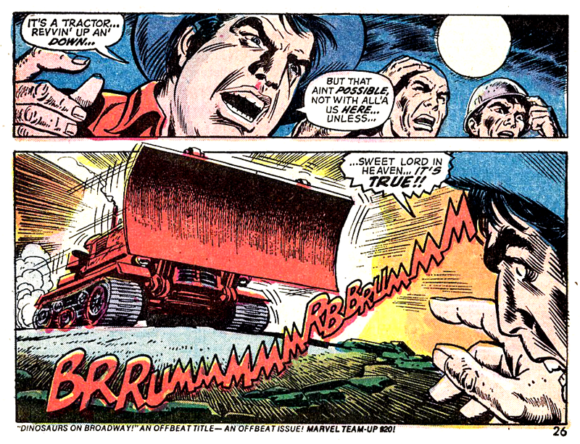
Dick Ayers and Ernie Chan deliver a highly effective art job, giving the entire book a real “men’s adventure” feel to the proceedings. Surprisingly, the Killdozer action sequences are generally kept to a minimum, heightening their effectiveness. The adaptation is more concerned with how the men trapped on this island deal with this insane situation, and each other. Ayers and Chan also get to cheat a little (in the Mighty Marvel Manner) by at times making Killdozer look much bigger than any actual bulldozer could be. They don’t go as far as Gil Kane did on the cover (I love Killdozer’s big, nasty, pointy teeth), but it makes the titular killer seem a lot more menacing than it ever does in the movie.
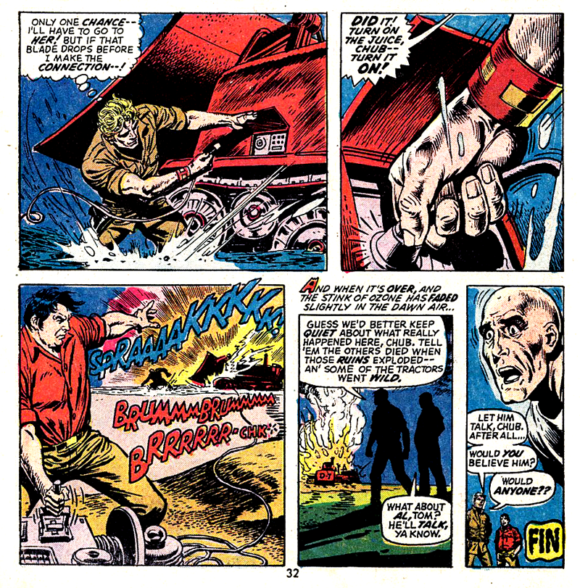
Killdozer was met with generally mixed-to-negative reviews when it aired, but it has gained a bit of a cult following over the years. A 1980s rock band named itself after the movie, and it was lovingly referenced more than once on Mystery Science Theater 3000. More bizarrely, there was a real life Killdozer in 2004 when a Colorado man named Marvin Heemeyer went on a rampage and used a souped-up bulldozer to demolish several city buildings, ending with his suicide. The sad story quickly became known as “The Killdozer rampage.”
Is Killdozer great cinema? Not really. For my tastes, it’s a little too restrained by its TV movieness to really deliver the kind of visceral punch this story needs, something the comic book manages to pull off. But it’s still fun, features some good performances, especially by the lantern-jawed lead, Clint Walker, and one of my favorite character actors, Neville Brand. It would make a great triple feature with other ’70s man vs. machine match-ups, Colossus: The Forbin Project and The Car. Too bad there aren’t comic book adaptations of those!
—
MORE
— WHAT IS BEST IN LIFE? 1982’s Gleefully Lusty CONAN THE BARBARIAN. Click here.
— Alex Toth, Jack Lemmon and 1965’s HOW TO MURDER YOUR WIFE. Click here.
—
Rob Kelly is a podcaster, writer, and illustrator. He is the host of various podcasts on the Fire and Water Podcast Network including Fade Out, Pod Dylan, TreasuryCast and M*A*S*HCast.

June 10, 2023
Strangely enough, I just finished painting a scene from that story as if it had been done on the original OUTER LIMITS, where it would have received better treatment than in the lackluster tv-movie. And here is a link to Gil Kane’s original art for the Marvel comic cover — I don’t know who redrew his work, but they did him no favors.
https://2.bp.blogspot.com/-THrA3YrmhBE/VyFkNptmEmI/AAAAAAABRuU/fSnZnC8jOFosDEI1rae0HTGVOsNWyL-1QCLcB/s1600/12499.jpg
June 11, 2023
How odd that Marvel adapted a TV movie. While it was adapting many TV series and theatrical movies at the time, I can’t think of other TV movies that were done. Since it was only shown once (not counting perhaps one or two repeats), I can’t imagine much motive from a marketing standpoint.